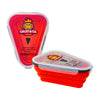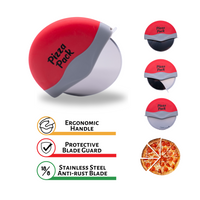Summary:
- Pizza has evolved into unique regional styles shaped by history, culture, and ingredients.
- Neapolitan pizza from Naples features a thin center, airy crust, and minimal toppings with strict authenticity rules.
- New York-style pizza is famous for its foldable, thin slices and versatility in toppings
- Chicago deep-dish pizza is thick, buttery, and layered in reverse with cheese on the bottom and sauce on top.
- Roman pizza offers thin, crispy crusts, often sold “al taglio” (by the cut).
- Other regional stars include Detroit-style with caramelized cheese edges and New Haven apizza, a coal-fired, charred specialty.
Pizza is one of the few foods that crosses borders effortlessly. From cozy trattorias in Italy to bustling pizzerias in New York and Chicago, every region has crafted its own unique take on dough, sauce, and cheese. What makes pizza fascinating is how culture, history, and local ingredients shape the style. Some prefer a thin, foldable slice that can be eaten on the go, while others crave a hearty deep-dish pie served like a casserole.
To understand what makes each version unique, let’s explore the world’s most iconic pizza styles: Neapolitan, New York, Chicago deep-dish, Roman, and other noteworthy regional twists.
Neapolitan Pizza (Naples, Italy)
The story of pizza begins in Naples, Italy. By the 1600s, Neapolitan pizza had become a staple for working-class people looking for a filling, affordable meal. Simple, humble ingredients turned into a tradition that would inspire countless variations worldwide.
The crust is what makes Neapolitan pizza unmistakable. It has a thin center that cooks quickly in a blazing-hot wood-fired oven, while the outer rim rises into an airy, chewy edge with light char marks.
For those who want to recreate that same texture at home, learning the science of hydration and oven temperature is key, and this guide to perfect pizza dough at home provides step-by-step tips.
The toppings are famously minimal: San Marzano tomatoes, fresh mozzarella, basil, and a drizzle of olive oil. These ingredients reflect Italian cuisine's “less is more” philosophy, where quality is prioritized over quantity.
Authenticity is taken seriously. The Associazione Verace Pizza Napoletana (AVPN) sets strict rules for what can be considered “true Neapolitan pizza.” Traditionally, Neapolitan pizzas are personal-sized and often eaten with a knife and fork, though some locals fold them in half and eat them on the street.
New York-Style Pizza
When Italian immigrants brought pizza to the United States in the early 1900s, New York City gave it its own twist. This style quickly became synonymous with American pizza culture.
The crust is thin yet sturdy, with a balance of crispness and chewiness that makes it easy to fold lengthwise. Folding a massive slice into a handheld meal has become a signature part of the New York pizza experience.
The toppings are more flexible than in Naples. A cooked tomato sauce is paired with shredded, low-moisture mozzarella; from there, the sky’s the limit. Pepperoni, mushrooms, sausage, and countless combinations make New York pizza endlessly adaptable.
Food historians and chefs alike point out that the city’s unique water chemistry may influence the dough’s texture, though others credit fermentation techniques and handling skills.
Chicago Deep-Dish Pizza
For those who think of pizza as comfort food, Chicago deep-dish is hard to beat. Invented in 1943 by Ike Sewell and Ric Riccardo at Pizzeria Uno, this style redefined expectations of what pizza could be.
The crust is thick and buttery, resembling more of a pie shell than a flatbread. It lines a deep pan, creating the foundation for generous layers.
What makes deep-dish exceptionally distinct is the reverse layering of toppings. Cheese goes down first, then meats and vegetables, and finally a chunky tomato sauce spread across the top. This layering protects the cheese from burning during the longer baking time.
A single slice is hearty enough to be a full meal. Deep dish is typically eaten with a knife and fork, and its richness makes it perfect for sharing with friends and family.
Roman-Style Pizza
While Naples gave the world soft and airy pizza, Rome developed its own crisp alternative. Roman pizza is known for its thin, cracker-like crust that stays crunchy all the way through. It is less chewy than Neapolitan and often baked in electric ovens rather than wood-fired ones.
Toppings lean toward fresh and seasonal ingredients, but the style leaves plenty of room for creativity. From zucchini blossoms to prosciutto, Roman pizzas showcase local produce in every bite.
One of the most recognizable ways Roman pizza is served is “al taglio”, which means “by the cut.” Large rectangular trays of pizza are baked, and customers order by length or weight. This makes it an easy street food option in Italy’s capital.
For an easy and delicious meal, try the Italian favorite, Chicken Pesto Pizza; it's a quick recipe you can even make at home.
Other Notable Styles
Beyond the big four, several regional styles have developed devoted followings:
Detroit-Style Pizza: Baked in rectangular steel pans originally used in auto factories, Detroit pizza has a thick, airy crust with edges caramelized by Wisconsin brick cheese. Sauce is typically spooned over the cheese in racing stripes.
New Haven Apizza: Known locally as “ah-beetz,” this Connecticut classic is coal-fired with a thin crust, chewy texture, and a signature char. The most famous version is the white clam pizza, which skips the tomato sauce in favor of garlic, olive oil, and fresh clams.
These variations show how local traditions and available ingredients influence what ends up on the plate.
Conclusion
Pizza’s journey from the streets of Naples to cities around the world is a story of adaptation and innovation. Each regional style tells its own tale, whether it’s the centuries-old simplicity of Neapolitan, the street-friendly New York slice, the indulgent Chicago deep-dish, or the crisp Roman squares sold al taglio.
Exploring these styles is more than just eating pizza; it’s about tasting history, culture, and creativity. And no matter which style you prefer, there’s always the same challenge: leftovers. To keep leftover pizza fresh and flavorful, storage solutions need to prevent soggy crusts and maximize fridge space. That’s where a collapsible pizza storage container like Pizza Pack makes a difference, keeping slices neat, sealed, and ready for the next meal.





